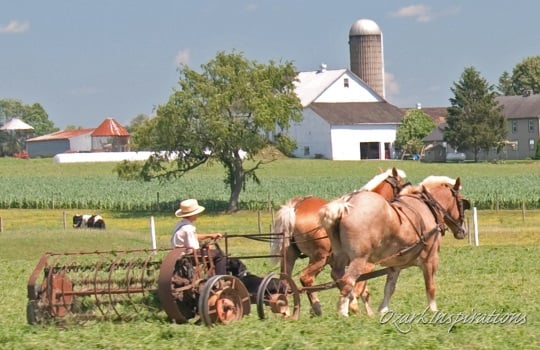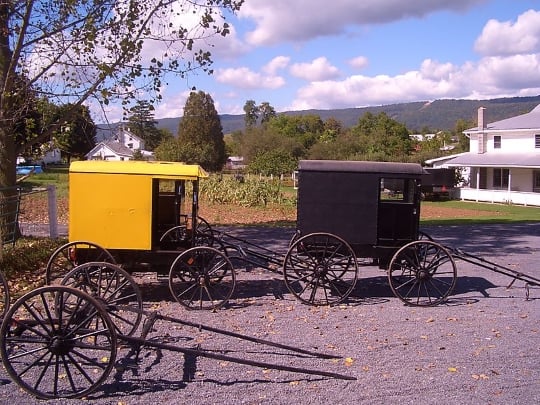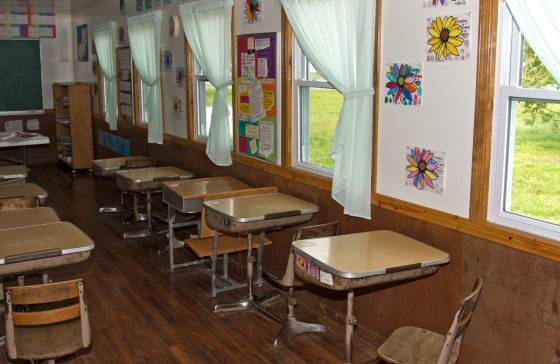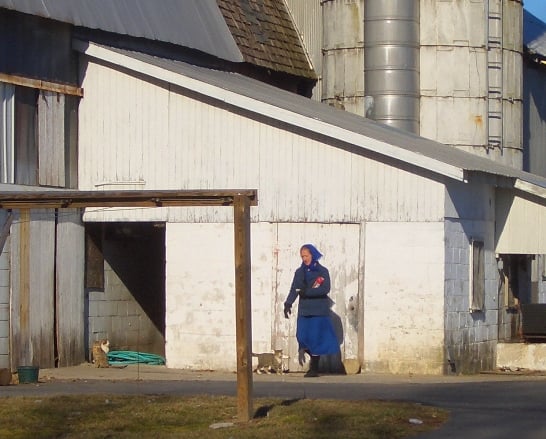A First Visit To Amish Pennsylvania (23 Photos)
Earlier this month, Don Burke gave us the story of how he first visited the Amish in Ohio, along with photos from that trip. We left off as he and his wife Pam were about to continue on — for a first visit to Lancaster County, Pennsylvania. So let’s rejoin them now for the next portion of the journey…

Don: As we ended the previous article in this series we were leaving Holmes County, Ohio heading for Lancaster County, Pennsylvania.
Pam: To get into the Pennsylvania portion of our first Amish trip requires back-tracking to some of the planning stages. Once we decided we were going to make the trip…
Don: What she means is once she decided after I had simply said “well, maybe someday….”
Pam: …what to do and where to stay became the big questions. To get help with these I contacted some of the Amish fiction authors I knew, and one of them posted my questions on her fan page. One reply that really caught my eye said something like, “How would you like to stay with a real Amish family?” Of course I pursued that and was put on the trail of Miriam’s Sleepover in Gordonville (Lancaster County).

Miriam and her husband Sam had a dawdi house addition to their home where Miriam’s parents and others had lived at various times. They later had electricity run into the addition and turned it into a guest house to rent out by the night.
So I called Miriam, left a message on her phone (which was located in the barn since local church rules didn’t allow one in their home), and waited for her to call back. After a couple of times of such back-and-forth communication, we had reservations for five nights (along with a special request from Don, which will be the subject of our next article).

In my mind’s eye, I was expecting a farm setting with an older, large frame house. What we found when we arrived at Miriam’s Sleepover was a nice modern brick home with a built-on modest, yet nicely furnished, guest house.

Don: Our first evening in Lancaster County we quickly discovered one of the characteristics of Amish country – businesses close earlier than we expected. It was about 8:30 when we arrived that evening, and we had not eaten. Since it is a high-tourist area, we thought finding a place to eat at that time of day would not be difficult. But it was.
The only place we eventually found open was a concession stand at a local baseball field, and it was closing up because the last ball game had just finished. So, we drive some 900 miles to immerse ourselves in Amish life of Lancaster County – and do so by eating close-out concession stand food in the dusky-dark as we watch the last of the Amish and English ballplayers leaving the ballfield.
Pam: During the next four-and-a-half days in Lancaster County, we had a variety of adventures. We visited a few of the “touristy” places and drove the back roads to enjoy the countryside.

Stops included the occasional Amish schoolhouse and some of the several covered bridges in the area.

Don: We noticed several things that composed the individual character of this Amish community. Scooters were very popular here, and apparently bicycles were not allowed.

Instead of the black-top buggies we had seen in Holmes County, here the buggy tops were gray.

And like the Amish man in OH had suggested, things here just had a bit more “spit-and-polished” – what some might consider to be brighter or even “showy” – than would be seen in Ohio or many other Amish areas.

Many of the farms had an eye-catching show-piece air about them. The various buildings around the farms were typically painted and well maintained.

And since the total acreage of the farms was relatively small – usually no more than around a hundred acres – the gently rolling hills around Lancaster displayed several beautiful well-maintained farm places cascading one after another as we looked over the countryside.

One of the places Pam particularly wanted to see was Amish Farm & House. Operated by non-Amish who knew the Amish culture well, guides explained various aspects of Amish life as we toured through a replica home, barns, a school and other places on this fifteen-acre attraction.


Pam: We tried some homemade root beer at a family-run road-side stand – which tasted a little better than the commercial product to this non-root-beer drinker.

We ate at some great restaurants and bought baked goods and other food items from small road-side stands and from larger places like the Bird-in-Hand Farmer’s Market – delicious foods like whoopie pie, snitz pie, shoo-fly pie.


Don: The Farmer’s Market will remain forever enshrined as the place I discovered Amish Butter Cheese. If ever there was a food that the angels in heaven envy us humans for, it is this cheese.
After discovering it here on our first day of sightseeing (then coming back a couple of days later for seconds!), I spent the next two years diligently searching for the place that made this cheese.
I eventually discovered that we had been within just a few miles of it earlier on this very trip! Contrary to what the name might suggest, Amish Butter Cheese is not made by the Amish, but was made by Guggisberg Cheese in Millersburg, Ohio.

Pam: On our last full day we attended the Heritage Days Festival in the small town of Intercourse and saw lots of Amish youth participating in volleyball and other activities.


These festivities ended with a night-time fireworks display that we got to watch with Miriam, Sam, and several members of their family from their front yard.

Don: This evening spent sitting with the family and watching the fireworks was my first real exposure to conversations in Pennsylvania Dutch, and I found it a bit captivating.
Although German-based languages can sound rough and harsh by their very nature, within this context of a loving family, friendly discussion, interspersed with gentle instructions and corrections to the youngest among the group, I found the tone of the language to be warm and friendly – even if I couldn’t understand a word that was being said.
Pam: One of the most special things about the week was the opportunity to visit with and get to know Miriam, an authentic Old Order Amish lady who gave me my first deeper real-life insights into “the Amish.”
Almost every afternoon or evening I had the chance to spend some time talking with her. She offered some wonderful recommendations for things to do, and she seemed to enjoy hearing what we had done, what new foods we had tried, and so on.

In one of our earliest conversations, we talked about how my interest in all things Amish had come from reading Amish fiction. To this day, as I continue to enjoy my Amish reading, I still see her smile and hear her voice saying, “Now, you know you can’t believe everything you read in those books!”
My biggest take-away from our stay in Lancaster County, though, was learning first-hand that Amish people are simply real people, just like the rest of us. Once we got through the obvious differences like clothes, transportation styles, technologies, and so on, we could find a lot of similarities in our lives.

Miriam and I shared some of the common difficulties and sorrows we had both experienced through the recent deaths of our mothers to Alzheimer’s. We talked about our children and the joys and concerns that came with them, both in her world and in mine.

When she discovered I was a teacher, we talked about school; she shared how the school system works in Amish communities, both past and present, and told me she wished school was in session so she could take me to visit a classroom (another item on my bucket list at that time).
Don: This takes us down to the very last day that we were in Lancaster County – and what would be the most memorable part of the whole trip for both of us. And we’ll discuss that in our next post.
Postscript: For those who may be wondering, Miriam’s Sleepover is no longer in operation. When we visited with Miriam and Sam again in 2012, she told us she was closing it down. Following a pattern that we’ve been told is common among the Amish, one of the youngest of their grown children, soon to be married, was going to move into the dawdi house.
The younger family would in the coming months and years begin to assume more and more responsibilities for the upkeep of the place. And in time as the young family grows and needs more space they will eventually swap living areas of the home with the parents/grandparents – giving the younger family the main portion of the house, and the older couple moving into the smaller dawdi house. In this way, it is common for the youngest among the children to take final long-term responsibility of the parents as they move into their advancing years.
If you’d like to see more, you can find all of Don’s Lancaster Amish photo albums here.






Navigating Lancaster
The first time we visited Lancaster county we mainly went to Sight and Sound Theater and then “randomly” navigated our way around with one of the tourist insert maps. I found purchasing an official detailed map was a very wise decision. The map includes many real Amish stores and places to stop as well as non-Amish and commercial attractions. Many chain restaurants and such where you can eat if local restaurants have closed for the day.
Same for Holmes county Ohio. Even though I live close and go there often, I keep an official detailed map in my car to go to off the beaten path places. They are the best, including back road places with the hand painted signs.
Where can u get a official detailed map at in Lancaster?
Sam & Miriam
WOW… Sam and Miriam & their families are some of my dearest friends.
Always warm, loving, inviting and genuine. While Miriam does not have her guesthouse any more, her niece Mim has an amazing Lodging not too far away which I highly recommend.
Mim's Lodging
I would be very pleased for more information about Mim’s Lodging and how to contact her. We travel to this area at least once a year and usually stay in New Holland or Ronks but would not be opposed to trying another place. Thank you!
Staying at an Amish Farm in Lancaster County
Deborah Miriam’s is no longer in operation but there are other farms where you can stay. Dave below beat me to it 🙂 but I was going to mention the site amishfarmstay.com.
Also here is our post on these farms from last year with a link back to that site:
https://amishamerica.com/6-lancaster-amish-farms-where-you-can-stay-as-a-guest/
Some nice-looking places on there, and it looks like since last year they’ve doubled their options to 12 different properties, not surprised as no doubt this is in demand, so you might want to book in advance if you plan to do that.
Thanks...
Thanks Local Lady for the additional information. As we were writing this article I recalled that Miriam had mentioned that one of her kin who was starting up a guesthouse, but I didn’t remember who or anything else.
Lodging
How can I get information about lodging please. I would love to visit this state and the Amish community there. We have a small community of Amish all around me and some neighbors as well. They also have a very nice little store two miles from my house that I shop at. Thank you for any info
Official detailed map.
My family is heading to Lancaster at the end of July. Where can we buy one of the official detailed maps at? We’ve always used one of the free ones when we go every year.
Tammy if you mean the detailed road maps, I’ve typically seen those at gas stations in the area. They should have the full County maps along with other regional maps. They might also be available at a place like the Discover Lancaster Visitors Center: https://www.discoverlancaster.com/
Amish Farm Stays in Lancaster County
Although Miriam’s Sleepover is no longer in operation, there’s a great selection of Amish Farm Guesthouses and B&B’s on the “Amish Farm Stay” website: https://amishfarmstay.com/
Thank you
Thank you for the Web site link.
Amish Farm Stays in Lancaster County
Really great pictures makes me want to get in my car and go visit for myself. Nice clean neat country.
Sam and Miriam
Miriam’s niece Mim (short for Miriam, named after her Aunt Miriam) has the most amazing guest house located in Christiana. It’s large and private and can host several couples or large families. There are animals on her farm and beautiful gardens.
Thanks for the info
Thank you all for the feedback and information. We have stayed at an Amish farm in Charm,OH many years ago. We grew up in southern NJ and have always loved the Lancaster area. We now live in TN but go back at least once a year. For many years we have been friends with an Amish couple in Ronks, Emanuel and Katie Fisher. They used to do dinners in their home and several times we even helped them serve. Sometimes there would be up to 30 people. We met people from all over the world at their home. We even served for them one night when they had a private group of Amish visiting from Ohio. We have such fond memories of our times with them. Unfortunately, the last time we visited Katie was not doing well and that was over a year ago. We try to stay away from the touristy area as much as possible when we are there. Again, thank you for your responses and for allowing me to reminisce a little.
Amish Hardware Store
Next time you venture into Lancaster Co. you need to check out the Holtwood Hardware Store located off Rt 372, a couple of miles, west of Rt 272. It is Amish owned and well worth the visit. It serves both the Amish and English people in the area
Amish Stores - Little Gems
Another great Amish store is
Fisher’s Houseware & Fabrics
1098 Georgetown Road in Bart.
Prices are great, lots of variety.
Whoops you missed it
about half way between Holmes Co., OH and Lancaster, PA, along the PA turnpike is Somerset County, the 2nd oldest Amish settlement in America, established around 1770, plus or minus. It is very rural and not commercial, like Lancaster or a lot of Holmes Co. Many of the mid-western Amish communities (OH, IN, IL etc.) where started from families migrating westward in the very late 1700s and early 1800s. Check it out the next time thru.
Hey Ron. I’m afraid my travels through PA have been few, with trips to Lancaster Co. in 2010 and 2012, then passing through on an autumn foliage trip of New England in 2016. Besides Lancaster Co. we’ve spent but a few hours in the Big Valley area, then hardly an hour in New Wilmington. At this point in life I’m not sure if there are any more trips to PA still in the future, but if so I would certainly hope to squeeze in a stop there in Somerset Co. Erik has done a piece on that settlement in the past, and it seems to be a place I would enjoy seeing.
Ron, good that you brought up that community, as Don mentioned I visited once, a snowy late-winter day four years ago, ended up being one of my favorite Amish visits. I picked up a community birthday calendar in one of the Amish stores, which I still have up on my wall.
Here’s the post I did on the visit if it’s of interest: https://amishamerica.com/somerset-county-pennsylvania/
detailed attraction map found
https://co.lancaster.pa.us/DocumentCenter/View/211/Historical-Attractions—Poster-Size
Thanks Jim! That’s a beautiful map.
Thanks, Don and Pam, for your article. I always enjoy your trips and photos. I appreciate you taking the time to get them to Erik to post. And, thanks Erik for doing so!
Kathy, glad you enjoyed it.
Lancaster PA
I’m ex amish from middlefield Ohio. Was born and raised here except for approximately 8 years we lived in Spartanburg PA. I was expecting you to say you went to sight and sound theater in Strasburg PA. This production is a must see. We have seen most of the musical shows and some twice. They also have one in Branson Missouri. A Christian production which is fantastic. Blessings to you and yours.